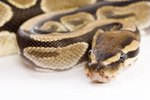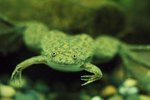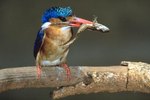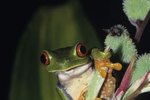
Frogs are among many species that have a third eyelid, or nictitating membrane. The membrane likely evolved to help the frog survive on land and in the water. It lubricates the eyes and provides a level of protection.
Structure
The nictitating membrane, also called a haw, extends from the frog’s lower lid. It is not muscle; it is epithelial tissue similar to the frog’s skin. It contains blood vessels, nerves and the connective tissue collagen.
Protection
The frog can raise the eyelid for extended periods of time to protect the eye from debris or other organisms. This is especially helpful during hibernation, when the frog may not be alert to imminent threats. Frogs pull up the the third eyelid during swimming to protect their eyes under water, much like the goggles you wear in the pool.
Moisture
The nictitating membrane helps an active, non-hibernating frog keep its eyes moist when out of the water on dry land. Without the membrane, a frog’s eyeball could become overly dry and impair his vision. Humans blink to keep moisture in the eye, but a frog needs a constant field of vision to seek out insects or other prey. Depending on the frog species, the nictitating membrane is either transluscent or transparent, so the frog won’t miss a potential meal when he flicks it periodically.
Nictitating Mebranes in Other Animals
Many species of fish, amphibians, reptiles, birds and mammals also have third eyelids. Primates and humans do not, with the exception of the aye aye, a type of lemur. Dogs and cats have a third eyelid that usually is engaged, only partially or fully, over the eyelid when the pet is dehydrated, ill or suffering from an eye infection or eye pain. Some puppies are born with a visible haw, which can be removed with surgery. Removing it may mean the dog will need artificial tears his entire life, however. In frogs, engagement of the nictitating membrane is completely normal.
References
- Investigative Opthamology and Visual Science: The Structure and Membrane Properties of the Frog Nictitans
- Henderson State University: How a Frog Hibernates
- "Frogs"; David P. Badger and John Netherton
- "Frogs: A Chorus of Colors"; John L. Behler et al.
- "Frogs, A Wildlife Handbook;" Kim Long
- Primate Info Net: Aye Aye
- WebMD: The Nictitating Membrane in Dogs
- VCA Animal Hospitals: Conjunctivitis in Cats
Photo Credits
-
Digital Vision/Photodisc/Getty Images
Writer Bio
Andrea Cespedes is a professionally trained chef who has focused studies in nutrition. With more than 20 years of experience in the fitness industry, she coaches cycling and running and teaches Pilates and yoga. She is an American Council on Exercise-certified personal trainer, RYT-200 and has degrees from Princeton and Columbia University.




